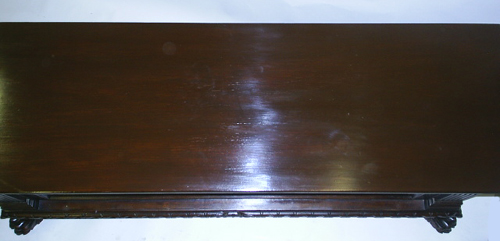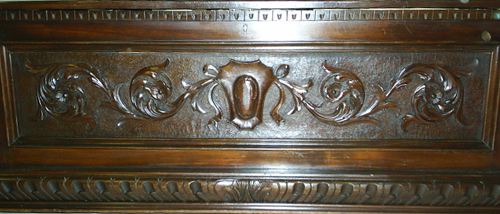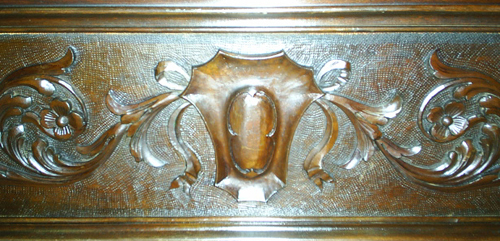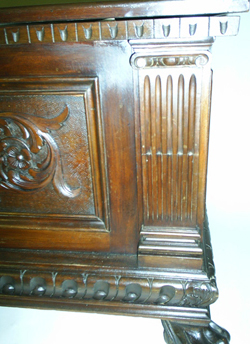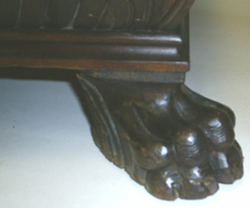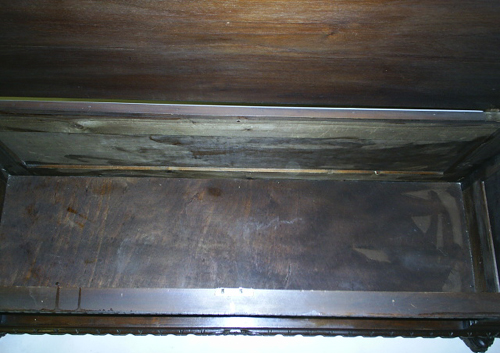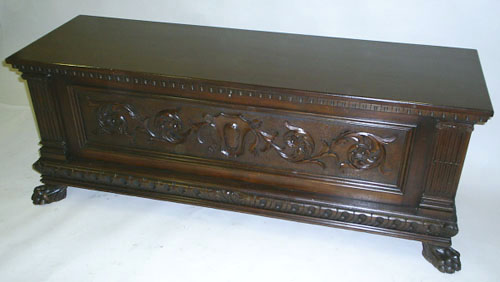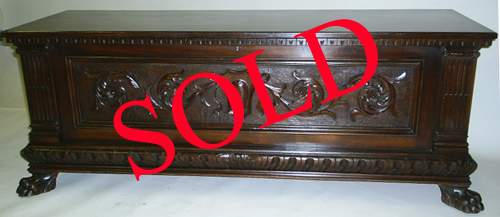
Ever since as graduate students we discovered the antique chests on display at the Gallery of the Accademia in Florence, we have been attracted to carved Italian chests in the classic Renaissance design. It was only later that we learned that the classic design on display there — relatively low and wide but shallow in depth — originated in Tuscany and spread throughout the peninsula. As the population grew prosperous, families sought a secure way to store precious possessions, which at that time had textiles at the top of the list of luxurious and valuable assets. Such a low and narrow design proved ideal for portability and security, meaning that a chest was difficult to swipe unobtrusively but easy to transport (one man could carry it on his back) when the need arose. The low and shallow design was also ideal for making folded textiles easy to find and extricate. And, in the spirit of multi-tasking, the chest could also be used for seating by placing a cushion on top.
In Florence, chests became associated with matrimony and were made in honor of a young woman's marriage — used as the repository for the textiles she brought with her as part of her dowry. The more elaborate the cassone, the wealthier the family whose success and prestige the cassone was designed to reflect when carried in a procession through the city from the bride's to the groom's home. According to tradition, upon arrival at the groom's home the cassone was opened to show his family that the dowry, including the valuables in the chest, was delivered.
Contemporary Florentine records show numerous workshops turning out cassoni, from the Latin for "boxes" or "cases." Such enterprises did everything from hewing the walnut to carving the decoration and, in the case of the more elaborate chests on display at the Accademia, employing the painters who depicted in extraordinary detail the marriage processions and other important events with which the chests were associated.
At the zenith of their popularity in the late 15th and early 16th centuries, chests were elevated above the floor by feet in the shape of intricately carved lions' paws — extending diagonally from the front of the chest and horizontally at the back (so that the chest could be pushed back flush with a wall). Art historians speculate that this was done not only for decorative beauty but to make it easier to view the decoration on the outside of the chest as well as the contents of the interior. Such external decoration included ornate combinations of carved vegetation, especially acanthus leaves, and heraldic symbols such as the family's coat-of-arms.
Applying this ample heritage to the chest we offer, it is evident that the 19th century craftsman responsible for this beautiful piece was well aware of its forebears and was striving to capture a flavor of 16th century Florence. First, he began with magnificent pieces of walnut whose deep, rich color and fine grain could negate the need for any decoration. The overall structure is classic and designed to show off the beauty of the wood. Such elements as the fluted pilasters at each side and the gadrooning along the base were also firmly entrenched in the Renaissance stylistic vocabulary he has drawn upon. In keeping with tradition, the front panel is decorated with swirling acanthus leaves and flowers flowing from a central cartouche where one would have expected a coat-of-arms. The intricately carved lions' paw feet reflect reverence for this stylistic innovation of centuries past as re-interpreted for a 19th century audience.
Reference
Antiquités et Objets D'Art 10, Le Mobilier Italien (Editions Fabri, Paris, 1990); Costantino Fioratti, Helen, Il Mobile Italiano (Giunti Editore, Firenze-Milano, 2004); Rousseau, Francis, Le Grand Livre des Meubles (Copyright Studio, Paris, 1999)
Uses
This chest would be ideal for its traditional function of storing valuable linens at the foot of the bed, but also as a bench in an entryway or in any room where additional storage space or seating would be useful. In keeping with a chest's connection to valuables, another possibility is using it as a base for a television.
